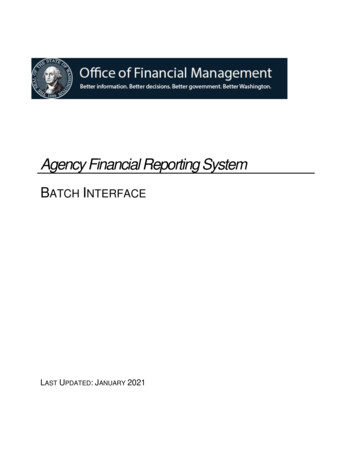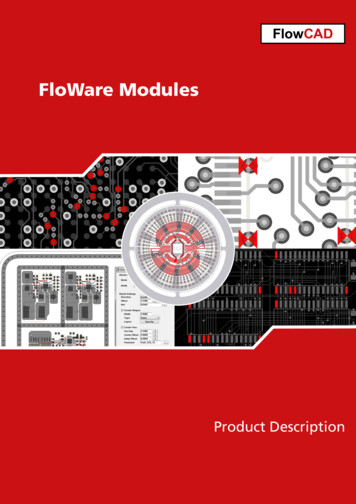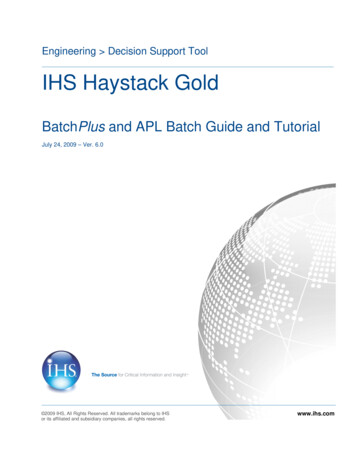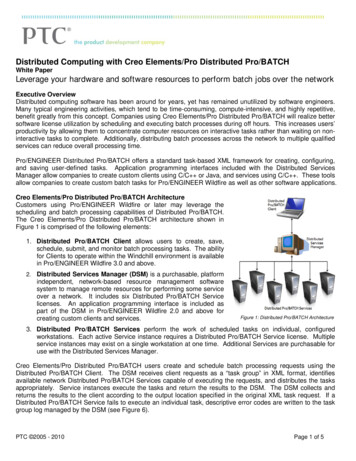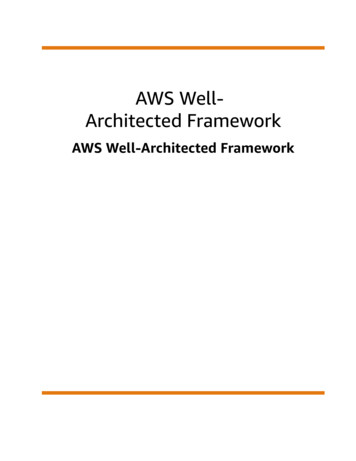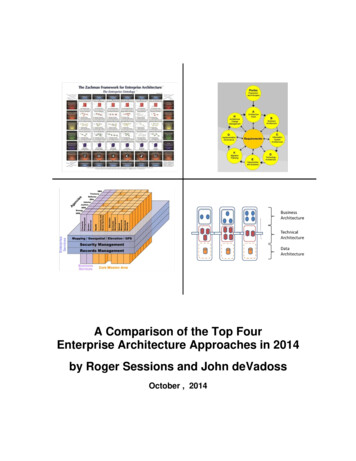
Transcription
ORACLE HYPERION ENTERPRISE PERFORMANCEMANAGEMENT ARCHITECT, FUSION EDITIONRELEASE 11.1.1.3BATCH CLIENT USER'S GUIDE
Performance Management Architect Batch Client User's Guide, 11.1.1.3Copyright 2006, 2009, Oracle and/or its affiliates. All rights reserved.Authors: EPM Information Development TeamThis software and related documentation are provided under a license agreement containing restrictions on use anddisclosure and are protected by intellectual property laws. Except as expressly permitted in your license agreement orallowed by law, you may not use, copy, reproduce, translate, broadcast, modify, license, transmit, distribute, exhibit,perform, publish, or display any part, in any form, or by any means. Reverse engineering, disassembly, or decompilationof this software, unless required by law for interoperability, is prohibited. The information contained herein is subject tochange without notice and is not warranted to be error-free. If you find any errors, please report them to us in writing.If this software or related documentation is delivered to the U.S. Government or anyone licensing it on behalf of the U.S.Government, the following notice is applicable:U.S. GOVERNMENT RIGHTSPrograms, software, databases, and related documentation and technical data delivered to U.S. Government customersare "commercial computer software" or "commercial technical data" pursuant to the applicable Federal AcquisitionRegulation and agency-specific supplemental regulations. As such, the use, duplication, disclosure, modification, andadaptation shall be subject to the restrictions and license terms set forth in the applicable Government contract, and, tothe extent applicable by the terms of the Government contract, the additional rights set forth in FAR 52.227-19, CommercialComputer Software License (December 2007). Oracle USA, Inc., 500 Oracle Parkway, Redwood City, CA 94065.This software is developed for general use in a variety of information management applications. It is not developed orintended for use in any inherently dangerous applications, including applications which may create a risk of personalinjury. If you use this software in dangerous applications, then you shall be responsible to take all appropriate fail-safe,backup, redundancy, and other measures to ensure the safe use of this software. Oracle Corporation and its affiliatesdisclaim any liability for any damages caused by use of this software in dangerous applications.Oracle is a registered trademark of Oracle Corporation and/or its affiliates. Other names may be trademarks of theirrespective owners.This software and documentation may provide access to or information on content, products, and services from thirdparties. Oracle Corporation and its affiliates are not responsible for and expressly disclaim all warranties of any kind withrespect to third-party content, products, and services. Oracle Corporation and its affiliates will not be responsible for anyloss, costs, or damages incurred due to your access to or use of third-party content, products, or services.
ContentsDocumentation Accessibility . . . . . . . . . . . . . . . . . . . . . . . . . . . . . . . . . . . . . . . . . . . . . . . 5Chapter 1. Using Performance Management Architect Batch Client . . . . . . . . . . . . . . . . . . . . . . . . . . . . . . . . 7Launching Batch Client . . . . . . . . . . . . . . . . . . . . . . . . . . . . . . . . . . . . . . . . . . . . . . . . . . 8Command Line Options . . . . . . . . . . . . . . . . . . . . . . . . . . . . . . . . . . . . . . . . . . . . . . . . . 8Return Codes . . . . . . . . . . . . . . . . . . . . . . . . . . . . . . . . . . . . . . . . . . . . . . . . . . . . . . . . 10Logging . . . . . . . . . . . . . . . . . . . . . . . . . . . . . . . . . . . . . . . . . . . . . . . . . . . . . . . . . . . . 12Chapter 2. Configuring Command Files . . . . . . . . . . . . . . . . . . . . . . . . . . . . . . . . . . . . . . . . . . . . . . . . . . . 15Variables . . . . . . . . . . . . . . . . . . . . . . . . . . . . . . . . . . . . . . . . . . . . . . . . . . . . . . . . . . . 16Comments . . . . . . . . . . . . . . . . . . . . . . . . . . . . . . . . . . . . . . . . . . . . . . . . . . . . . . . . . . 17Commands . . . . . . . . . . . . . . . . . . . . . . . . . . . . . . . . . . . . . . . . . . . . . . . . . . . . . . . . . 17Scripts . . . . . . . . . . . . . . . . . . . . . . . . . . . . . . . . . . . . . . . . . . . . . . . . . . . . . . . . . . . . . 19Commonly Used Commands . . . . . . . . . . . . . . . . . . . . . . . . . . . . . . . . . . . . . . . . . . . . . 19Option Commands . . . . . . . . . . . . . . . . . . . . . . . . . . . . . . . . . . . . . . . . . . . . . . . . . 19Login / Logout Commands . . . . . . . . . . . . . . . . . . . . . . . . . . . . . . . . . . . . . . . . . . . 19Copy Commands . . . . . . . . . . . . . . . . . . . . . . . . . . . . . . . . . . . . . . . . . . . . . . . . . . 20Create Commands . . . . . . . . . . . . . . . . . . . . . . . . . . . . . . . . . . . . . . . . . . . . . . . . . 21Create Association Commands . . . . . . . . . . . . . . . . . . . . . . . . . . . . . . . . . . . . . . . . 22Delete Association Commands . . . . . . . . . . . . . . . . . . . . . . . . . . . . . . . . . . . . . . . . 23Delete Commands . . . . . . . . . . . . . . . . . . . . . . . . . . . . . . . . . . . . . . . . . . . . . . . . . 23Detach Dimension Commands . . . . . . . . . . . . . . . . . . . . . . . . . . . . . . . . . . . . . . . . 24Exclude Commands . . . . . . . . . . . . . . . . . . . . . . . . . . . . . . . . . . . . . . . . . . . . . . . . 25Execute Commands . . . . . . . . . . . . . . . . . . . . . . . . . . . . . . . . . . . . . . . . . . . . . . . . 25Include Commands . . . . . . . . . . . . . . . . . . . . . . . . . . . . . . . . . . . . . . . . . . . . . . . . 29Insert Commands . . . . . . . . . . . . . . . . . . . . . . . . . . . . . . . . . . . . . . . . . . . . . . . . . . 29Move Commands . . . . . . . . . . . . . . . . . . . . . . . . . . . . . . . . . . . . . . . . . . . . . . . . . . 30Rename Commands . . . . . . . . . . . . . . . . . . . . . . . . . . . . . . . . . . . . . . . . . . . . . . . . 30Remove Commands . . . . . . . . . . . . . . . . . . . . . . . . . . . . . . . . . . . . . . . . . . . . . . . . 31Share Dimension Commands . . . . . . . . . . . . . . . . . . . . . . . . . . . . . . . . . . . . . . . . . 31Update Commands . . . . . . . . . . . . . . . . . . . . . . . . . . . . . . . . . . . . . . . . . . . . . . . . . 32Index . . . . . . . . . . . . . . . . . . . . . . . . . . . . . . . . . . . . . . . . . . . . . . . . . . . . . . . . . . . . . . 35Contentsiii
ivContents
Documentation AccessibilityOur goal is to make Oracle products, services, and supporting documentation accessible, withgood usability, to the disabled community. To that end, our documentation includes featuresthat make information available to users of assistive technology. This documentation is availablein HTML format, and contains markup to facilitate access by the disabled community.Accessibility standards will continue to evolve over time, and Oracle is actively engaged withother market-leading technology vendors to address technical obstacles so that ourdocumentation can be accessible to all of our customers. For more information, visit the OracleAccessibility Program Web site at http://www.oracle.com/accessibility/.Accessibility of Code Examples in DocumentationScreen readers may not always correctly read the code examples in this document. Theconventions for writing code require that closing braces should appear on an otherwise emptyline; however, some screen readers may not always read a line of text that consists solely of abracket or brace.Accessibility of Links to External Web Sites in DocumentationThis documentation may contain links to Web sites of other companies or organizations thatOracle does not own or control. Oracle neither evaluates nor makes any representationsregarding the accessibility of these Web sites.TTY Access to Oracle Support ServicesOracle provides dedicated Text Telephone (TTY) access to Oracle Support Services within theUnited States of America 24 hours a day, seven days a week. For TTY support, call 800.446.2398.5
6Documentation Accessibility
Using PerformanceManagement Architect BatchClient1In This ChapterLaunching Batch Client . 8Command Line Options . 8Return Codes .10Logging.12Oracle Hyperion EPM Architect, Fusion Edition Batch Client enables you to combine processessuch as data export, metadata loads, data loads, and calculations and kick off these operationsduring your normal nightly or weekly load process.The batch client enables you to kickoff processes using external scheduling tools. You can usethe batch client to perform many tasks, including:lLoad metadata into Performance Management ArchitectlUpdate security related properties on dimensions and measureslLoad data to applicationsThe batch client is installed automatically when you install Performance Management Architect.You can run the batch client on Windows platforms. When you install PerformanceManagement Architect, a batch file is automatically created to setup the class paths that aregenerated during installation.You can run the Performance Management Architect Batch Client in two modes:llCommand line modemYou can enter commands interactivelymEach command can span multiple linesmCommand statements are terminated by a semi colon delimiter ‘;’mMust use single quotesmCommands are executed immediatelyScript modemmExecutes a series of commands without your interactionYou can specify a command file and optionally a result log file and trace log file atprogram startup7
mYou can schedule the execution of script using a third party schedulerLaunching Batch ClientYou can run the Performance Management Architect Batch Client in interactive command linemode or execute a script file specified on the command line.ä To launch the Batch Client, select Start, Programs, Oracle EPM System, Foundation Services,Performance Management Architect, Start EPMA Batch Client.You can also navigate to HYPERION HOME\products\Foundation\BPMA\EPMABatchClient and execute the epma-batch-client.bat file using an interactivecommand line or script.For example, to launch the batch client in interactive command mode launch the batch file withno parameters:HYPERION -batchclient.bat.When executing a script the script file name must be specified with the –C option. All additionalparameters are optional. For example: HYPERION -batch-client.bat –CMyScript.txtNote: You can specify the script file name and any log file names as relative paths, however thepaths must be relative to the EPMABatchClient folder, not the folder in which the batchfile was launched.Command Line OptionsYou can specify the following arguments when you start the batch client.Table 1Batch Client CommandsCommandDescription-HDisplays batch client help.-CSpecifies the name of the script file to execute.For es the language to use. To use this parameter, enter –Gx where x is one of the following hlFR—FrenchlIT—ItalianUsing Performance Management Architect Batch Client
CommandDescriptionlJA—JapaneselKO—KoreanlPT BR—Brazilian ZH CN—Simplified ChineselZH TW—Traditional ChineseFor example, –Gfr for French or –Git for Italian.If the –G option is not specified the Batch Client attempts to use the current default language from theoperating system. If a resource file is not found the Batch Client will use the default, English. If a stringis not found in a specific language resource file, the English version will be used.-TSpecifies output trace file.For example: -T’C:\LogFiles\Trace.log’-RSpecifies the name of the file to write the results to on your machine.For example: -R’C:\LogFiles\ScriptResult.log’-LSpecifies if commands are logged. The default value is 0.Log Commands include:Off (Default) Do not log commandsOn Log CommandsFor example: -LOn-SStops execution of the script if a command fails. The default value is 1 (true).Stop if an error occurs: TrueContinue on Error: FalseFor example: -SFalse, continues if an error occurs.-USpecifies the user name used to login to Performance Management Architect.For example: -U’Admin’-PSpecifies the password used to login to Performance Management Architect.For example: -Ppassword-VTurns script verification on or off. If Validate is on, the script is checked for syntax errors before it is runand the script will abort if any errors are found. The value 'Off' does not validate before execution and'On' validates the script before executing. The default value is On and validates the script beforeexecuting. For example, -VOff does not validate the script before execution.-OValidate Only. If specified, the Batch Client validates the script but, pass or fail, it will not run the script.This can be used to test a script for syntax errors without running it.Command Line Options9
Note: For On/Off command line parameters, such as –S, the following values are acceptable: 0or 1, Y or N, Yes or No, True or False, On or Off. For example, these values are all valid:-S0, -SY, -SNo, -STrue, -SOff.The following excerpt shows an example of how command line options are used.epma-batch-client -Hepma-batch-client -C"C:\Hyperion\EPMA\Commands.txt" “-R"C:\Hyperion\EPMA\ResultFile.txt" -LOn -SFalse–Uadmin -PpasswordReturn CodesWhen the Batch Client exits it returns a result code to the calling program based on the exitcondition of the script. There are two possible scenarios based on the StopOnError setting.StopOnError False (-S0)If StopOnError is false the return code indicates general success or failure.0 success (no errors)-1 failure (one or more errors occurred)StopOnError True (-S1)When StopOnError is true the Batch Client exit when an error occurs and returns a code basedon the following table. By default, StopOnError is set to True.The batch client returns the following result codes in the event of success or failure.10CommandCommand CodeClassClass CodeReturn CodeSuccessN/AN/AN/A0General ErrorN/AN/AN/A-1Validation ErrorN/AN/AN/A1Parse ErrorN/AN/AN/A100Command Line reate1Member3103Using Performance Management Architect Batch Client
CommandCommand CodeClassClass CodeReturn rn Codes11
CommandCommand CodeClassClass CodeReturn 03Variable14N/A01400In a DOS batch file or Windows command file the error can be checked as follows:Call epma-batch-client.bat .\scripts\MyScript.txtIF ERRORLEVEL 0 goto ON SUCCESSIF ERRORLEVEL 100 goto PARSE ERRORIf ERRORLEVEL 101 goto APP CREATE FAILEDLoggingThe batch client provides several levels of logging through result and trace files. Result filescontain details of the commands and their execution status, error, or warning messages. Tracefiles contain a detail stack trace that is useful for debugging purposes.The batch client uses the log4j for logging. You can format the output of the result and tracefiles, for example, you can configure the log4j to transmit messages to new type of writer, suchas E-mail. All of the configuration parameters are stored in BPMAPlusLog4j.properties inthe conf directory. For example, HYPERION ut.The following excerpt shows an example of a result file.log4j.appender.resultfile .resultfile.File .appender.resultfile.MaxFileSize 1024KBlog4j.appender.resultfile.MaxBackupIndex 5log4j.appender.resultfile.layout tfile.layout.ConversionPattern %d EPMABatch: %m%nTo help you determine if the command was successful, the associated JobID and the JobID URLis logged for the following commands:12lExecute DeploylExecute ReDeploylExecute ValidatelExecute DataSynchronizationlExecute ImportlCopy ApplicationUsing Performance Management Architect Batch Client
lDetach DimensionlShare DimensionLogging13
14Using Performance Management Architect Batch Client
Configuring Command Files2In This ChapterVariables .16Comments .17Commands .17Scripts.19Commonly Used Commands.19A command file is an input file for the batch client. It can contain one or more of the following:lCommandslVariables, declarations, and assignmentslCommentsThe following excerpt is an example of a command file.// Test Scriptset bpmaserverurl http://localhost/hyperion-bpma-server;set workspaceurl http://localhost:19000/workspace;login admin,password;set ApplicationName 'Sample';// Delete some membersDelete MemberProperties(MemberName, DimensionName, ParentName, RemoveChildren)Values('M1-1-1', 'A1', 'M1-1', true);Delete MemberProperties(MemberName, DimensionName, ParentName, RemoveChildren)Values('M1', 'A1', '#root', false);Delete MemberProperties(MemberName, DimensionName, ParentName, RemoveChildren)Values('M1', 'A1', '#root', true);Delete ete DimensionProperties(DimensionName)15
Values('E1');Delete App1');set ApplicationName '';// Delete shared dimsDelete t;Most of the commands in a command file execute immediately. However, EXECUTE commandscan take a long time to execute and support a WaitForCompletion parameter. All executecommands support this parameter, except for DIMSYNCRONIZATION. For example, you canuse a WaitForCompletion parameter to force the batch client to wait for command execution.The following command shows an example of the WaitForCompletion parameter. In this case,the administrator is executing a data synchronization command, which can take longer to run.Other commands that take longer to run include imports and application deployments.execute ame, , FileName, UploadFile,ValidateOnly, WaitForCompletion)values('CommaSync3', '*', '1.2345', '', 'false', 'false', 'true');VariablesYou can define variables and also call them in scripts. Characteristics of variables include:lVariables have a name and a single value typelThe value of a variable can be any data typelYou can define a variable once and use it in multiple placeslYou can change the value of a variable between commandslVariable names are case sensitivelYou can use the keyword, var to define a variable, and refer to the variable using The following excerpt shows an example of using variables to create a shared dimension.// Create Shared Dimension Scriptset bpmaserverurl http://localhost/hyperion-bpma-server;set workspaceurl http://localhost:19000/workspace;login admin,password;var DimType 'Scenario';// Create a shared dimensioncreate Dimension16Configuring Command Files
Properties(DimensionName, DimensionDescription, DimensionType)Values('S1','New Scenario',' DimType');There are three types of variables:lUserUser variables are assigned using the keyword, var. For example:var variable1 'abc';lSystemSystem variables are assigned using the set command. For example:set bpmaserverurl 'http://localhost/hyperion-bpma-server';set workspaceurl 'http://localhost:19000/workspace';lObjectObject variables are assigned using the set command. For example:set ApplicationName 'Comma';set dimension Account;CommentsYou can comment out any line in a script by using two forward slashes // at the beginning ofthe line. If a line spans into multiple lines, you must comment out each line separately. Forexample://execute datasynchronization// parameters(DataSynchronizationName, , FileName, UploadFile,//ValidateOnly, WaitForCompletion)// values('CommaSync3', '*', '1.2345', '', 'false', 'false', 'true');CommandsA command consists of a:lCommand verblCommand classlParameter–Value collection or a Property-Value collectionParameters and values are separated by commas. Supported command verbs include:lCREATElCOPYlDEBUGlDELETEComments17
lSETlVARIABLESupported command classes LOYlDATASYNCHRONIZATIONlREDEPLOYlVALIDATETip: Use the constant #root for the root member of a dimension. Use the constant #sharedfor the application name for commands targeted at the Shared Library.18Configuring Command Files
ScriptsScripts are a collection of commands that can be executed sequentially. Scripts can havecommands in any sequence, however, certain initialization commands like login must executebefore others. Each command in a script is separated by a semi colon ‘;’. Commands can containwhite spaces and span multiple lines.Commonly Used CommandsThe following sections provide examples of commonly used commands.Option CommandsYou can use the Option command to dynamically modify command line options during theexecution of a script. You can change the following options:StopOnErroroption StopOnError true;EchoCommentsoption EchoComments true;LogCommandsoption LogCommands true;Login / Logout CommandsloginLogs into Performance Management Architect.If you login using a script, enter:Login admin,password;If you login using a command line, enter:Login;LogoutLogs out of Performance Management Architect.Logout;QuitCloses the batch client.Quit;Scripts19
ExitCloses the batch client.Exit;Copy CommandsApplicationThe Copy Application command is the same as the "Duplicate As New" command available inthe Application Library.Copy ApplicationProperties ( ApplicationName, CopyApplicationToName,ApplicationDescription, ApplicationType)Values( 'Comma', 'CommaCopy', 'Copied App Desc', 'Consolidation');ApplicationName—The name of an existing application.CopyApplicationToName—The name of the new duplicated application.ApplicationDescription—The application description.ApplicationType—Type of application. Valid values are: Generic, Consolidation, Planning,Profitability, Enterprise Analytics, or Essbase Analytics.DimensionProvides a way to copy dimensions within the Shared Library, within an application, or betweenthe Shared Library and an application. You cannot copy a dimension directly from oneapplication to another.Copy DimensionProperties(ApplicationName, DimensionName, tApplicationName)Values('#Shared', 'Scenario','CopyScenario', 'Copy of Scenario Dim',Comma');ApplicationName—The name of an existing application.DimensionName—The name of an existing dimension.TargetDimensionName—The name of the target dimension.TargetDimensionDescription—The description of the target dimension.destApplicationName—The name of the destination application.20Configuring Command Files
Create CommandsApplicationCreates a new, empty application with the specified name.Create ApplicationProperties(ApplicationName, ApplicationDescription, ApplicationType)Values('Comma', 'Description for Comma', 'Consolidation');Application Name—A string containing a valid name for the application.ApplicationDescription—A string containing a valid name for the application.ApplicationType—Supports the following values:lGenericlConsolidationlPlanninglEnterprise AnalyticslEssbase AnalyticslProfitabilityDimensionCreates a new, empty dimension in the specified application or in the Shared Library.Create DimensionPproperties(ApplicationName, DimensionName, 'Test Account','Test Account','Account');ApplicationName—The name of an existing application. Use #Shared to create a dimensionin the Shared Library.DimensionName—A valid name for the dimension.DimensionType—Dimension Type can be any one of the cCommonly Used Commands21
lUDAlValuelVersionlViewlYearMemberCreates a new member in the specified dimension.Create MemberProperties(ApplicationName, DimensionName, ParentName, r Dim', '#root', 'TestMember1', 'Description forTestMember1');ApplicationName—The name of an existing application. Use #Shared to create a dimensionin the Shared Library.DimensionName—The name of an existing dimension.ParentName—The name of the parent under which to insert the newly created member. Use#Root to add a new member at the top level of the tree.MemberName—A valid name for the new member.MemberDescription—A description for the new member.Create Association CommandsCreates an association between two dimensions. If the base dimension is shared the associateddimension must be a shared dimension.Create AssociationProperties(ApplicationName, DimensionName, iption)Values(‘Comma’, ‘Scenario’, 'AttribDim', 'AttribProp', 'Attrib PropDesc');ApplicationName—The name of an existing application.DimensionName—The name of an existing dimension.AssociatedDimensionName—The name of the dimension that you are associating with.22Configuring Command Files
PropertyName—The name of the property to update. (You can list as many properties as desired,however, you must include a valid value for the property.PropertyDescription—An optional parameter that you can use to enter a comment or propertydescription.Delete Association CommandsDeletes an existing dimension association.Delete AassociationProperties(ApplicationName, DimensionName, PropertyName)Values(‘Comma’, ‘Scenario’, 'SecurityClass');ApplicationName—The name of an existing application.DimensionName—The name of an existing dimension.PropertyName—The name of the property to update. (You can list as many properties as desired,however, you must include a valid value for the property.)Delete CommandsApplicationDeletes the specified application.Delete a');ApplicationName—The name of an existing application.AssociationDeletes an existing dimension association.Delete AassociationProperties(ApplicationName, DimensionName, PropertyName)Values(‘Comma’, ‘Scenario’, 'SecurityClass');ApplicationName—The name of an existing application.DimensionName—The name of an existing dimension.PropertyName—The name of the property to update. (You can list as many properties as desired,however, you must include a valid value for the property.)DimensionDeletes the specified dimension.Commonly Used Commands23
Delete DimensionProperties(ApplicationName, DimensionName)Values('Comma','C Scenario');ApplicationName—The name of an existing application. Use #Shared to delete a dimensionin the Shared Library.DimensionName—The name of an existing dimension.MemberDeletes the specified member and optionally all of the member's children.Delete MemberProperties(ApplicationName, DimensionName, ParentName, MemberName,RemoveChildren)Values('Comma','C nName—The name of an existing application. Use #Shared to delete a member froma dimension in the Shared Library.DimensionName—The name of an existing dimension.ParentName—The name of the parent under which to delete the member. Use #Root whendeleting a member at the top level of the tree.MemberName—The name of the member to delete.RemoveChildren—Indicates if any children under the member being deleted should also bedeleted. Allowed values are:lTruelFalseDetach Dimension CommandsConverts a shared dimension in an application to a local dimension.Detach DimensionProperties(ApplicationName, DimensionName, itForCompletion)Values('Comma', 'Period', 'true', 'true', 'true');ApplicationName—The name of an existing application.DimensionName—The name of an existing dimension.RetainFilteredStructure—If set to true, the
m You can schedule the execution of script using a third party scheduler Launching Batch Client You can run the Performance Management Architect Batch Client in interactive command line mode or execute a script file specified on the command line.
